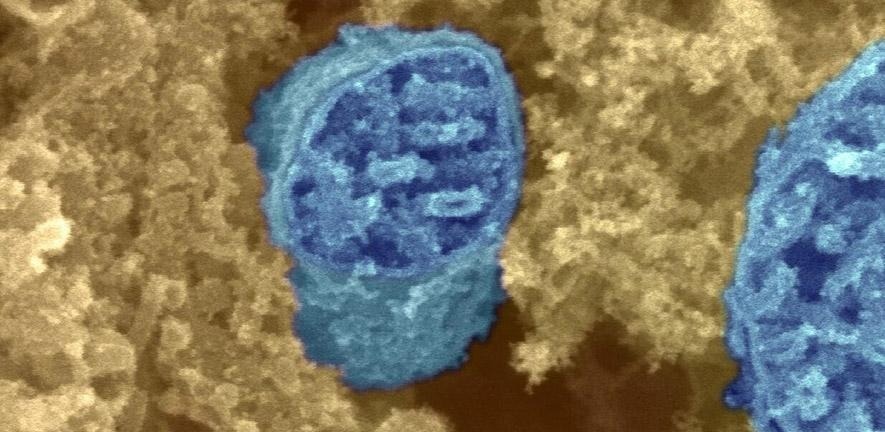Reviewed by Danielle Ellis, B.Sc.Oct 6 2022
Researchers discovered that in one out of every 4,000 births, some of the genetic code from the mitochondria—the “batteries” that power human cells—inserts itself into the DNA, giving a startling new insight into how humans evolve.
 Mitochondria surrounded by cytoplasm. Image Credit: Dr David Furness
Mitochondria surrounded by cytoplasm. Image Credit: Dr David Furness
Researchers from the University of Cambridge and the Queen Mary University of London demonstrate that mitochondrial DNA exists in some cancer DNA, implying that it serves as a bandage to repair damage to the genetic code in a study published today in Nature.
Mitochondria are small “organelles” that reside within human cells and function as batteries, supplying energy in the form of the molecule ATP to power the cells. Each mitochondrion has its own DNA, known as mitochondrial DNA, that differs from the rest of the human genome, which is made up of nuclear DNA.
Mitochondrial DNA is carried down the maternal line, which means it is acquired from the mother rather than the father. However, in 2018, investigators from the Cincinnati Children’s Hospital Medical Center in the United States released a study in PNAS that revealed some mitochondrial DNA had been transferred down the paternal line.
The Cambridge researchers examined the DNA of more than 11,000 families enlisted in Genomics England’s 100,000 Genomes Project in an effort to verify these claims. They looked for patterns that suggested paternal inheritance.
Scientists discovered mitochondrial DNA “inserts” in certain children’s nuclear DNA that were not present in their parents’ nuclear DNA. This indicated that the US researchers had likely drawn the incorrect conclusion since what they had actually seen was these insertions rather than paternally inherited mitochondrial DNA.
By expanding this research to over 66,000 individuals, the team has now demonstrated that the new inserts are truly occurring constantly, illuminating a novel mode of genome evolution.
Billions of years ago, a primitive animal cell took in a bacterium that became what we now call mitochondria. These supply energy to the cell to allow it to function normally, while removing oxygen, which is toxic at high levels. Over time, bits of these primitive mitochondria have passed into the cell nucleus, allowing their genomes to talk to each other.”
Patrick Chinnery, Professor, Medical Research Council Mitochondrial Biology Unit and Department of Clinical Neurosciences, University of Cambridge
Professor Patrick Chinnery adds, “This was all thought to have happened a very long time ago, mostly before we had even formed as a species, but what we've discovered is that that’s not true. We can see this happening right now, with bits of our mitochondrial genetic code transferring into the nuclear genome in a measurable way.”
According to the researchers, mitochondrial DNA passes to nuclear DNA in approximately one out of every 4,000 births. If that person has children, they will pass on these inserts—the scientists discovered that the majority carry five of the new inserts, and one in seven (14%) possess the most recent ones. Once implanted, the inserts can occasionally cause extremely rare disorders, such as a rare genetic form of cancer.
It is unclear how mitochondrial DNA inserts itself, whether directly or through an intermediary such as RNA, but Professor Chinnery believes it is most likely to occur within the mother’s egg cells.
When the researchers examined the DNA sequences from 12,500 tumor samples, they discovered that mitochondrial DNA was much more common in tumor DNA, occurring in approximately one in 1,000 tumors, and in some cases, the mitochondrial DNA inserts actually cause cancer.
Our nuclear genetic code is breaking and being repaired all the time. Mitochondrial DNA appears to act almost like a Band-Aid, a sticking plaster to help the nuclear genetic code repair itself. And sometimes this works, but on rare occasions if might make things worse or even trigger the development of tumors.”
Patrick Chinnery, Professor, Medical Research Council Mitochondrial Biology Unit and Department of Clinical Neurosciences, University of Cambridge
The sections of the genome that code for proteins are where more than half (58%) of the insertions occurred. In most cases, a molecule latches to the insert and turns off the insert as soon as the body recognizes the invasive mitochondrial DNA. This process is known as methylation.
When viruses are able to implant themselves into human DNA, a similar process takes place. This method of silencing is imperfect, though, because certain mitochondrial DNA inserts copy themselves and travel within the nucleus.
The researchers searched for proof that the opposite can occur—that the nuclear DNA might be partially absorbed by the mitochondria—but they did not find anything. There are probably a number of explanations for why this is the case.
Cells only have two copies of nuclear DNA but thousands of copies of mitochondrial DNA, therefore the likelihood of mitochondrial DNA being damaged and moving into the nucleus is considerably higher than the reverse.
Also, mitochondrial DNA is bundled inside two membranes, and there are no pores in the membrane, making it difficult for nuclear DNA to enter. If mitochondrial DNA escapes, perforations in the membrane enclosing nuclear DNA would allow it to slip through quite easily.
I am so delighted that the 100,000 Genomes Project has unlocked the dynamic interplay between mitochondrial DNA and our genome in the cell’s nucleus. This defines a new role in DNA repair, but also one that could occasionally trigger rare disease, or even malignancy.”
Sir Mark Caulfield, Professor and Vice Principal, Health, Queen Mary University of London
Source:
Journal reference:
Wei, W., et al. (2022) Nuclear-embedded mitochondrial DNA sequences in 66,083 human genomes. Nature. doi.org/10.1038/s41586-022-05288-7